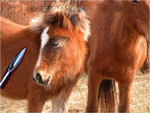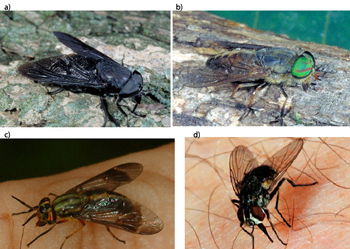TOPICS
- Home
- Challenges
- EIA Virus
- Transmission NEW!!
- Persistent Infection
- Pathogenesis
- Immune Response
- Diagnosis & Control
- Field Studies
- Publications NEW!!
- Links
- Contact and Credits
HOT TOPICS IN EIA RESEARCH
Transmission
EIA is best thought of as a blood-borne infection. Mechanical transfer of blood from one equid to another has the potential to transmit EIAV and is the usual means of transmission in nature. The level of the virus in the blood and the amount transferred are the major determinants of transmission. As the level of virus can be so variable and as there are no accurate ways of predicting the level from day to day, we must assume that all infected equids pose a risk for transmission. Quantitation of that risk, however, can be accomplished for purposes of comparison between the important determinants of transmission.
The vector with the highest potential to transfer EIAV between horses is man, mostly because of the potential to transfer large volumes of blood, e.g., several hundred milliliters in a plasma transfusion. At the other end of the spectrum, estimates of blood remaining on the mouthparts of a medium-sized horsefly after being interrupted in its feeding are in the range of 0.00001 milliliter. More than a million fold greater potential for man. To highlight the importance of man, we have attached a file titled "Transmission of EIA virus by man: Reducing risks from blood collections" to the list of publications.
Those insect vectors that inflict pain or other defensive behavior by the horse are more likely to be interrupted in their feeding and transfer to a second host. The blood contamination of the insect mouthparts can then mechanically carry and transfer EIAV to the second host as it slices and dices its way to the next blood source. Horseflies and deer flies (Tabanids) appear to be the best vectors; individually, the risk for transmission is low, even from a horse with acute clinical signs of EIA and an extremely high level of virus.
Rarely, however, do horses encounter individual insects. In one study in Louisiana, over a thousand horseflies were noted to attempt feeding on a horse within one hour! Collectively, the risk increases exponentially.
By comparison, when a person removes the syringe and needle after taking a jugular blood sample from a horse, notes and manually wipes the blood spot off the neck of the horse, there may be in excess of 0.1 milliliter of blood on the person's finger. The equivalent of about 10,000 horsefly bites. If the horse was infected with EIAV there could be in excess of 100,000 infective doses in that one drop of blood. Huge potential for transmission, fortunately one that is rarely realized.
Updated on: February 17, 2010


